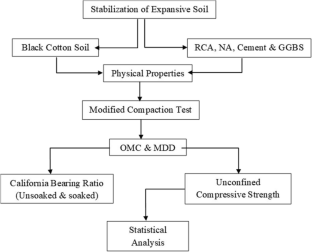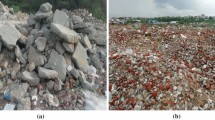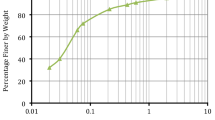Abstract
The primary objective of this research was to explore the potential utilization of waste materials, specifically recycled concrete aggregate (RCA) and granulated blast-furnace slag (GGBS), in combination with black cotton soil for pavement infrastructure. To achieve this goal, the study undertook both experimental and statistical analyses of subgrade layer properties stabilized with RCA and GGBS. Various mechanical properties, like California bearing ratio (CBR) and unconfined compressive strength (UCS), were examined with different compositions. These compositions involved with the 15% replacement of soil to aggregate (natural and RCA) and binder (cement and GGBS). As a benchmark, no stabilization soil also considered in the investigation. The experimental findings indicated that soil stabilized with 10% natural aggregate and 5% cement offered higher result compared to other combinations considered. However, black cotton soil stabilized with 10% RCA and 5% GGBS also exhibited promising results in terms of CBR and UCS tests. To further validate these results, a probabilistic study was conducted, considering ten different probabilistic distributions. The selection of the best-fit distribution was based on goodness-of-fit (GOF) tests performed on available experimental data. However, out of ten distributions, the Log-normal distribution observed as most suitable for the soil, stabilized with RCA and GGBS. In summary, the integration of waste materials such as RCA and GGBS not only promising an acceptable result but also offering environmental benefits by contribute to the development of sustainable pavement construction.












Similar content being viewed by others
Data availability
All the data considered in the present study are belongs to our owns. There is no data is used from any other researchers.
References
Sharma AK, Sivapullaiah PV (2016) Ground granulated blast furnace slag amended fly ash as an expansive soil stabilizer. Soils Found 56(2):205–212
Tavakol M, Hossain M, Tucker-Kulesza SE (2019) Subgrade soil stabilization using low-quality recycled concrete aggregate. Eighth International Conference on Case Histories in Geotechnical Engineering. American Society of Civil Engineers, Reston, VA, pp 235–244
Shourijeh PT, Rad AM, Bigloo FHB, Binesh SM (2022) Application of recycled concrete aggregates for stabilization of clay reinforced with recycled tire polymer fibers and glass fibers. Constr Build Mater 355:129172
Ali AM, Tobeia SB (2022) Mechanical Stabilization of Weak Sand Subgrade Using Recycled Concrete Aggregate. J Eng Sci Technol 17(1):0239–0256
Shamsi Susahab J, Ardakani A, Hassanlourad M (2024) Strength improvement of clay subgrade soil stabilised with recycled concrete aggregate and granulated blast furnace slag. Road Materials and Pavement Design, 1–16
Hoyos LR, Puppala AJ, Ordonez CA (2011) Characterization of cement-fiber-treated reclaimed asphalt pavement aggregates: preliminary investigation. J Mater Civ Eng 23(7):977–989
BIS (Bureau of Indian Standards) (1983) Methods of test for soils, Part VIII: Determination of water content-dry density relation using heavy compaction. IS 2720, New Delhi, India
MoRTH (Ministry of Road Transport and Highways) (2013) Specifications for road and bridge works. Indian Roads Congress, New Delhi, India
Ikeagwuani CC, Nwonu DC (2019) Emerging trends in expansive soil stabilisation: A review. J Rock Mech Geotechn Eng 11(2):423–440
Oza JB, Gundaliya PJ (2013) Study of black cotton soil characteristics with cement waste dust and lime. Procedia Eng 51:110–118
Sipani N, Sharma S (2021) A review on comparative study of stabilization of black cotton soil by different chemical stabilizers. Indian Geotechnical Conference. Springer Nature Singapore, pp 279–284
BIS (Bureau of Indian Standards) (1987) Methods of test for soils, Part XVI: Laboratory determination of CBR. IS 2720, New Delhi
BIS (Bureau of Indian Standards) (1991) Methods of test for soils, Part X: Determination of unconfined compressive strength. IS 2720, New Delhi, India
IRC (Indian Roads Congress) (2018) Guidelines for the design of flexible pavements. IRC 37, New Delhi, India
Kianimehr M, Shourijeh PT, Binesh SM, Mohammadinia A, Arulrajah A (2019) Utilization of recycled concrete aggregates for light-stabilization of clay soils. Constr Build Mater 227:116–792
IRC (Indian Roads Congress) (2018) SP: 89, Part: II. Guidelines for the design of stabilized pavements. New Delhi
Giri JP, Priyadarshini M, Mahakhud R (2022) Variability in the compressive strength of paving blocks using waste plastic. Recent advances in materials, mechanics and structures: In Proceedings of ICMMS 2022. Springer Nature Singapore, pp 575–583
Mahakhud R, Priyadarshini M, Giri JP (2023) Utilization of ground granulated blast-furnace slag powder in brick industry: A new generation building material. Mater Today: Proc
Priyadarshini M, Giri JP (2022) Use of recycled foundry sand for the development of green concrete and its quantification. J Build Eng 52:104474
Forbes C, Evans M, Hastings N, Peacock B (2011) Statistical distributions. Wiley
BIS (Bureau of Indian Standards) (1985) Methods of test for soils, Part V: Determination of liquid and plastic limit. IS 2720, New Delhi
BIS (Bureau of Indian Standards) (1972) Methods of test for soils, Part VI: Determination of shrinkage factors. IS 2720, New Delhi
BIS (Bureau of Indian Standards) (1980) Methods of test for soils, Part III: Determination of specific gravity, Section 1: Fine grained soils. IS 2720, New Delhi
BIS (Bureau of Indian Standards) (1963) Methods of test for aggregates for concrete, Part III. IS 2386, New Delhi
BIS (Bureau of Indian Standards) (1963) Methods of test for aggregates for concrete, Part IV. IS 2386, New Delhi
BIS (Bureau of Indian Standards) (1988) Methods of physical tests for hydraulic cement, Part IV: Determination of consistency of standard cement paste, Part VI. IS 4031, New Delhi
BIS (Bureau of Indian Standards) (1988) Methods of physical tests for hydraulic cement, Part III: Determination of soundness. IS 4031, New Delhi
BIS (Bureau of Indian Standards) (1996) Methods of physical tests for hydraulic cement, Part I: Determination of fineness by dry sieving. IS 4031, New Delhi
BIS (Bureau of Indian Standards) (1988) Methods of physical tests for hydraulic cement, Part XI: Determination of density. IS 4031, New Delhi
BIS (Bureau of Indian Standards) (1988) Methods of physical tests for hydraulic cement, Part V: Determination of initial and final setting times. IS 4031, New Delhi
Funding
The authors declare that no funds, grants, or other support were received during the preparation of this manuscript.
Author information
Authors and Affiliations
Contributions
All authors contributed to the study conception and design. Material preparation, data collection, and analysis were performed by Sourav Kumar Nanda, Jyoti Prakash Giri, and Monalisa Priyadarshini. The first draft of the manuscript was written by Jyoti Prakash Giri and all authors commented on previous versions of the manuscript. All authors read and approved the final manuscript.
Corresponding author
Ethics declarations
Competing interests
The authors have no relevant financial or non-financial interests to disclose.
Additional information
Publisher's Note
Springer Nature remains neutral with regard to jurisdictional claims in published maps and institutional affiliations.
Rights and permissions
Springer Nature or its licensor (e.g. a society or other partner) holds exclusive rights to this article under a publishing agreement with the author(s) or other rightsholder(s); author self-archiving of the accepted manuscript version of this article is solely governed by the terms of such publishing agreement and applicable law.
About this article
Cite this article
Nanda, S.K., Giri, J.P. & Priyadarshini, M. Quantitative evaluation of soil stabilization using RCA and GGBS: a statistical perspective. J Build Rehabil 9, 89 (2024). https://doi.org/10.1007/s41024-024-00444-0
Received:
Revised:
Accepted:
Published:
DOI: https://doi.org/10.1007/s41024-024-00444-0




